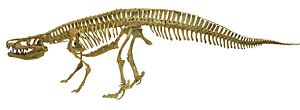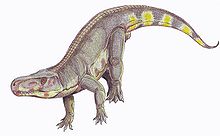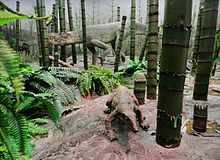Batrachotomus
| Batrachotomus | ||||||||||||
|---|---|---|---|---|---|---|---|---|---|---|---|---|

Reconstructed skeleton of Batrachotomus kupferzellensis |
||||||||||||
| Temporal occurrence | ||||||||||||
| Ladinium to Carnium ( Trias , Keuper ) | ||||||||||||
| 235 to 228 million years | ||||||||||||
| Locations | ||||||||||||
|
||||||||||||
| Systematics | ||||||||||||
|
||||||||||||
| Scientific name | ||||||||||||
| Batrachotomus | ||||||||||||
| Gower , 1999 | ||||||||||||
| Art | ||||||||||||
|
||||||||||||
Batrachotomus ( Greek " Lurch butcher") is a genus of extinct archosaurs from the Keuper (235 to 228 mya ), ie about the middle of the Triassic . The fossils of the type species were found near Kupferzell in Baden-Württemberg.
features
Postcranial skeleton
Batrachotomus was a heavily built, four-legged Pseudosuchia (or Crurotarsi) of the Prestosuchidae family , which could reach a length of five to six meters. On his back he had armor plates ( osteoderms ), which were connected to the vertebrae by strong muscles. So the animal was able to bend its spine and reach high speeds in a galloping gait. These flat bone plates ran from the neck along the spine and became smaller towards the end of the tail, with osteoderms and vertebrae arranged in a 1: 1 ratio. It appears that the underside of the tail as well as the abdomen and limbs were covered with osteoderms, similar to those of Ticinosuchus ferox .
Like other rauisuchers , Batrachotomus had an upright posture, which means that he kept his legs almost vertically under the body, and not bent to the side like recent crocodiles. His extremities were not of the same length, the front legs only reached around 70 percent of the length of the hind legs. The toe bones are generally poorly preserved, the only well preserved being a fifth metatarsal . It is believed that Batrachotomus had four toes on the front feet and five toes on the back feet.
Skull and teeth
Batrachotomus had a tall, narrow, 40 to 50 centimeter long skull. This had five skull windows on each side, one for the eyes and one for the nostrils. Behind the bony eye sockets ( orbits ) were two temple windows (fenestrae temporales) on each side. These possibly reduced the weight of the skull and made it possible to open the jaws wider. As a typical archosaur, Batrachotomus had a triapsid skull , so it had an opening ( fenestra antorbitalis = antorbital window) between the nasal and eye sockets. A fifth pair of small openings was in the back of the lower jaw (fenestrae mandibulares = mandibular window ).
The jaws had narrow, sharp teeth of different sizes and shapes ( heterodontics ). The teeth on the intermaxillary bone (premaxillary) were narrow, unlike those in the upper jaw (the bone in the upper jaw that bears most of the teeth). The upper jaw had 30 teeth, with each premaxillary having 4 teeth and each maxillary having 11 teeth. The lower jaw had 22 teeth.
habitat
Since 1977, rich finds of the flora and vertebrate fauna of Kupferzell have given insight into the environment of the Lower and Early Middle Keuper in Baden-Württemberg and suggest a swampy, flat landscape ("Keuperglades", analogy to Everglades , a comparable tropical landscape in Florida) , with islands thickly overgrown with huge horsetail like Equisetites . As the water level rose and fell, the islands were repeatedly connected to the mainland, so that a constant exchange of flora and fauna could take place. In addition to Batrachotomus , various species of fish were found, including some primeval ray-fins , most commonly small 10 to 20 centimeter long ganoid scales of the genera Serrolepis and Gyrolepis . Likewise, they found temnospondyli amphibians as Trematolestes , probably as a present-day Gavial captured fish, or the flat, bottom-dwelling gerrothorax , was one of the so many copies of each other that one assumes that they settled in the bottom of the swamps crowded. The largest amphibian that shared the habitat with Batrachotomus was the six-meter-long mastodonsaurus , also a large temnospondylian living in the water. Tooth traces of Batrachotomus were found on his skeletons , which is why he got his name "Lurchschlächter".
literature
- Rainer Schoch (Ed.): Saurier. Expedition into prehistoric times. Thorbecke, Ostfildern 2007, ISBN 978-3-7995-9089-1 .
- Michael J. Benton : The Evolution of Early Amniotes. Michael J. Benton: Vertebrate Palaeontology. 3rd edition. Blackwell, Malden MA et al. 2005, ISBN 0-632-05637-1 , pp. 106-135.
- Michael J. Benton, Alick D. Walker : Erpetosuchus, a crocodile-like basal archosaur from the Late Triassic of Elgin, Scotland. In: Zoological Journal of the Linnean Society. Vol. 136, No. 1, 2002, ISSN 0024-4082 , pp. 25-47, doi : 10.1046 / j.1096-3642.2002.00024.x .
- David J. Gower: The cranial and mandibular osteology of a new Rauisuchian Archosaur from the Middle Triassic of southern Germany (= Stuttgart contributions to natural history. Series B: Geologie und Paläontologie. Vol. 280, ISSN 0341-0153 ). State Museum for Natural History, Stuttgart 1999, digitized version .
- David J. Gower: Braincase evolution in suchian archosaurs (Reptilia: Diapsida): evidence from the rauisuchian Batrachotomus kupferzellensis. In: Zoological Journal of the Linnean Society. Vol. 136, No. 1, 2002, pp. 49-76, doi : 10.1046 / j.1096-3642.2002.00025.x .
- David J. Gower, Rainer R. Schoch : Postcranial Anatomy of the Rauisuchian Archosaur Batrachotomus kupferzellensis. In: Journal of Vertebrate Paleontology. Vol. 29, No. 1, 2009, ISSN 0272-4634 , pp. 103-122, doi : 10.1080 / 02724634.2009.10010365 .
- J. Michael Parrish: Phylogeny of the Crocodylotarsi, with reference to archosaurian and crurotarsan monophyly. In: Journal of Vertebrate Paleontology. Vol. 13, No. 3, 1993, pp. 287-308, doi : 10.1080 / 02724634.1993.10011511 .
- Brigitte Rozynek: Schozachia donaea n. Gen., N. Sp., A new cycad megasporophyll from the Middle Triassic (Ladinian) of Southern Germany . In: Palaeodiversity. Vol. 1, 2008, pp. 1–17, (PDF; 10.1 MB).
- Kasturi Sen: A new rauisuchian archosaur from the Middle Triassic of India. In: Palaeontology. Vol. 48, No. 1, 2005, ISSN 0031-0239 , pp. 185-196, doi : 10.1111 / j.1475-4983.2004.00438.x .
- William D. Sill: The anatomy of Saurosuchus galilei and the relationships of the rauisuchid thecodonts. In: Bulletin of the Museum of Comparative Zoology. Vol. 146, No. 7, 1974, ISSN 0027-4100 , pp. 317-362, digitized .
Web links
- The "amphibian butcher" Batrachotomus on bestiarium.kryptozoologie.net
- Batrachotomus on palaeos.com (English)


